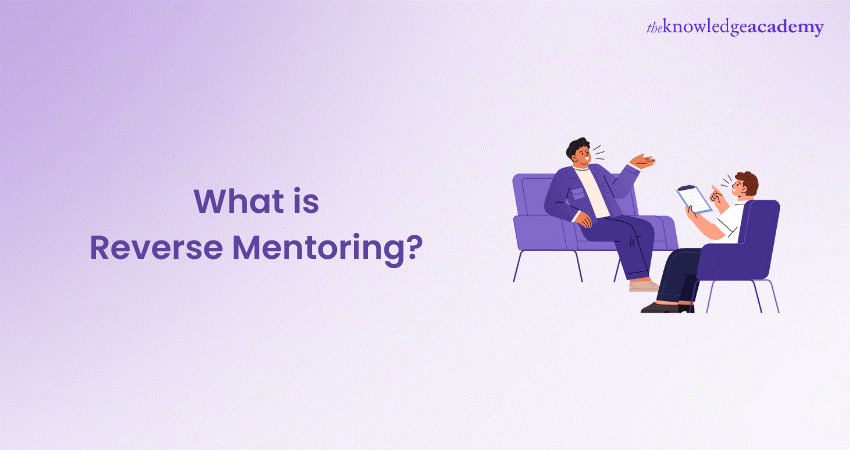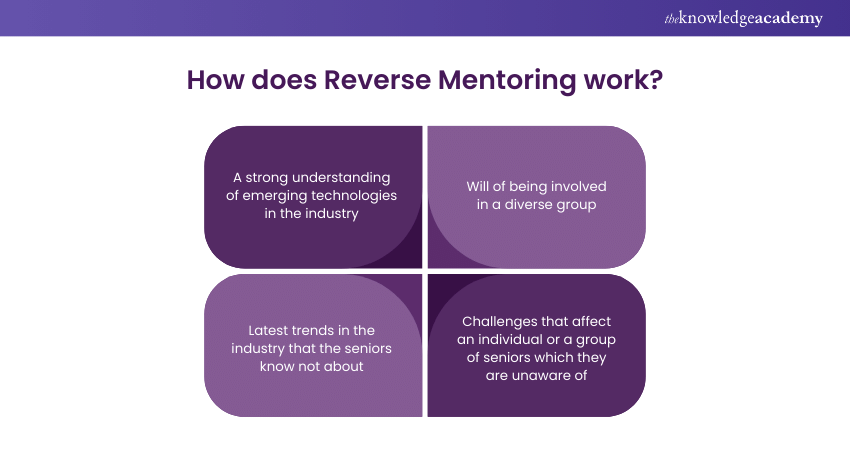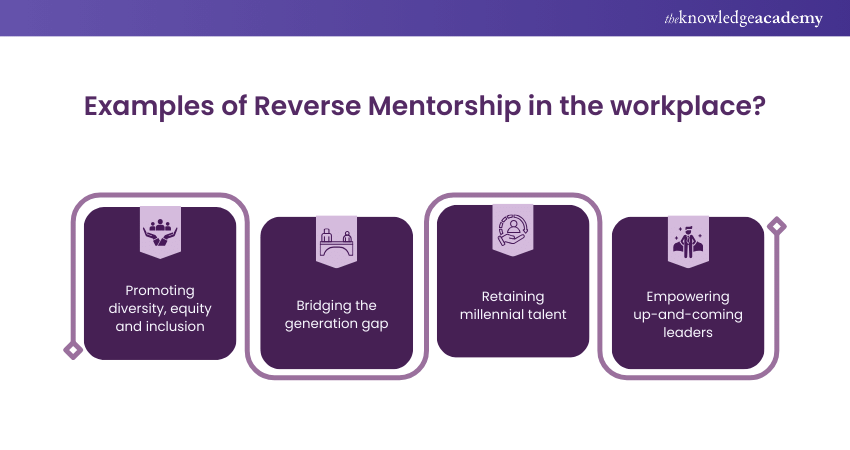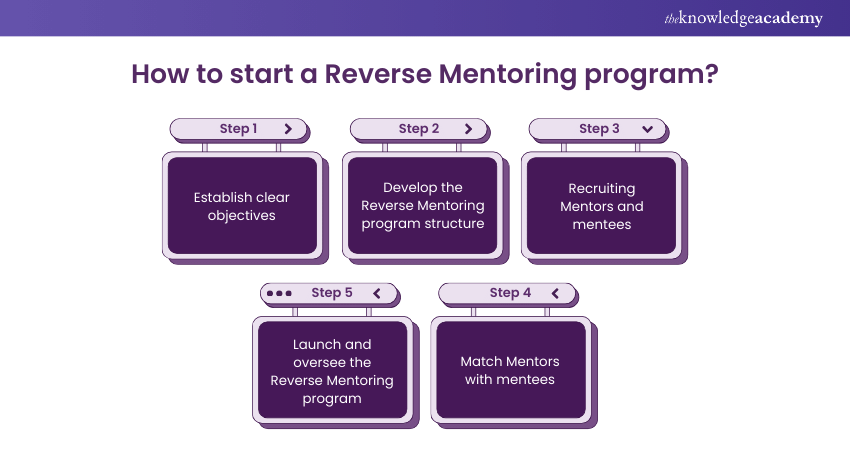We may not have the course you’re looking for. If you enquire or give us a call on +60 1800812339 and speak to our training experts, we may still be able to help with your training requirements.
Training Outcomes Within Your Budget!
We ensure quality, budget-alignment, and timely delivery by our expert instructors.

Reverse Mentoring is a challenge to the notion which believes that wisdom can only flow in one direction. It is a traditional thought and approach, where the workspace believes that only senior executives are eligible to offer value and knowledge to juniors.
It is defined as a transfer of skills and knowledge typically from someone who has considerably less experience, or a junior, to a senior. Over the past few years, there has been a surge in Reverse Mentoring. It offers a plethora of benefits in the domain of career development. Explore every element, benefit, importance, and guideline related to Reverse Mentoring in this blog.
Table of Contents
1) Definition of Reverse Mentoring
2) Importance of Reverse Mentoring
3) How does Reverse Mentoring work?
4) Examples of Reverse Mentoring in the workplace
5) How to start a Reverse Mentoring Program?
6) Guidelines for Reverse Mentoring
7) Conclusion
Definition of Reverse Mentoring
Reverse Mentoring, simply put, can be defined as a situation when a junior Mentors someone senior. The idea behind this practice is the belief that the junior has greater expertise in technology, digital media, etc. A senior executive might not always possess expertise in these particular fields.
When practiced correctly, Reverse Mentoring can be very effective in team development and reducing generational gap. This practice is an essential part of diversity, inclusion and leadership initiative.
It also disrupts the idea of Mentoring as an elitist concept. The sole purpose of this practice is to share Mentoring Skills for professional development.
Importance of Reverse Mentoring
Reverse Mentoring is still comparatively a new concept, which is gaining more attention with passing days. Organisations often strive to promote inter-generational collaboration and mutual understanding. Thus, at its core, Reverse Mentoring encourages sharing without prejudices.
With digital transformation becoming undeniable, it is established that change is good. Here are some examples that will help you understand the importance of Reverse Mentoring:

1) Building a culture of transparency and trust
2) Appreciating and supporting generational knowledge
3) Supporting all generational inclusivity
4) Promoting diversity
5) Increase in employee engagement
6) Developing future leaders
7) Professional development of both generations
Disseminate knowledge and sharpen your active listening skills by signing up for our Train the Trainer Course now!
How does Reverse Mentoring work?
One of the greatest elements of this Mentoring practice is that it does not deviate much from the classic Mentoring approach. Reverse Mentoring, in fact, follows the same guidelines as a traditional Mentoring method. However, the only key difference is that the Mentor is not the senior, and the mentee is the senior. Even with unlimited possibilities, there are some key areas which make Reverse Mentoring work:

1) A strong understanding of emerging technologies in the industry
2) Will of being involved in a diverse group
3) Challenges that affect an individual or a group of seniors which they are unaware of
4) Latest trends in the industry that the seniors know not about
Some amount of friction was witnessed while practicing Reverse Mentoring. The biggest difficulty that arises is due to the generational differences and stereotypes. This problem can be fixed with open communication and instilling a sense of mutual respect. It is important to respect each other’s values, experiences and perspectives.
Get familiarised with effective coaching by signing up for our Coaching Skills Course now!
Examples of Reverse Mentorship in the workplace?
Reverse Mentorship approach offers many benefits. Let’s explore some of the examples:

Promoting diversity, equity and inclusion
Inclusion and diversity have been a long-drawn issue in the corporate world for many years. Companies are in constant need to embrace diverse cultural leadership. Reverse Mentorship presents opportunities for under-represented employees to gain a certain degree of exposure to leaders. This practice does not only help the juniors but also gives leaders a fresh perspective.
Bridging the generation gap
This Mentoring practice closes the generational gap in the company. Seniors, too, get a platform to learn more about newer ideas, technology, and industry trends. Whereas the juniors too get access to perform a Leadership act.
Retaining millennial talent
Recently, millennials are having negative feelings about the companies’ ethics and policies. One of the biggest reasons being, they feel neglected by the seniors. This leads them to leave the workplace, abruptly at times. However, when the Reverse Mentorship module is practiced in the workplace, it demonstrates management’s interest in millennial workers’ well-being.
Empowering up-and-coming leaders
It is essential to empower emerging leaders. This means that individuals require proper training and guidance to carry out leadership roles in the future. With this Mentoring style, youngsters develop needful Communication Skills and boost their self-confidence.
Transform your training skills—join our Train the Trainer Courses and become the trainer who makes a difference!
How to start a Reverse Mentoring program?
Listed below are the steps that to start a Reverse Mentoring program:

Step 1: Establish clear objectives
The first step is to describe the purpose of the Reverse Mentoring program. The goal of this step is to identify which use of the Mentorship style is most critical for the people.
Step 2: Develop the Reverse Mentoring program structure
Once the needful is mapped out, it is time to invest in the details. The outline needs to have certain details like:
1) Selecting participants of the program
2) Number of spaces available
3) Length of the process
4) How would people sign up for the program
5) The expected commitment
6) What is the monitoring process of the progress
Step 3: Recruiting Mentors and mentees
After fixing the program, it is time for onboarding Mentors and mentees separately. the program now needs to be promoted through internal communication channels. It is better if you can identify target participants individually and send invites to them personally. Communicating the benefits of the program is necessary.
Step 4: Match Mentors with mentees
One of the most crucial parts of setting up Reverse Monitoring is deciding to match Mentors and mentees. This depends on how many participants there are in the program. Matches, typically, are made based on the skill set held by the Mentor and the required improvement spheres of the mentees.
Step 5: Launch and oversee the Reverse Mentoring program
Once the program is set and Mentor with mentees are matched, it is fit to be officially launched. The prime goal of the step is to build a sense of community amongst all participants. This, in turn, helps to increase the commitment of the employees. In order to get a good start, provide necessary resources and support to both sides – Mentors and mentees.
Track the frequency at which the Mentor and mentees are meeting, and then create a system for receiving feedback from the participants. This will help you to understand if the program is really working towards your desired goal.
Guidelines for Reverse Mentoring
As discussed earlier, Reverse Mentoring is not very different from standard Mentoring procedure. The Mentor and mentees roles are just reversed, where seniority is not a factor in being the Mentor. Here are the guidelines for this Mentorship program:
Finding a suitable Reverse Mentor
Finding the right Mentor in this setting might be a challenging task compared to traditional Mentoring styles. As a Reverse Mentor, it might feel intimidating Mentoring seniors. However, the aim is exactly that, Mentoring seniors helping them get upskilled.
Establishing expectations
It is crucial to set expectations at the beginning of the Mentorship program. A tendency to take control might be seen from the seniors' end, which needs to be controlled. It is important to set clear instructions about who the Mentor is in the setting.
Providing experience-based guidance and Mentorship
Learning curve is dependent on hands-on experience, the failures and the mistakes made. The more encouragement you show towards Mentoring, the more growth you can witness. It provides experience-based guidance that can help mentees to not repeat any previously made mistakes.
Conclusion
Reverse Mentoring can reap numerous benefits and help organisations grow. It is a powerful tool to support all employees. With uses such as inclusion, leadership development, upskill, if practiced properly, can be truly profitable.
Learn all about Mentoring and coaching with our Coaching and Mentoring Course – join today!
Frequently Asked Questions

Reverse Mentoring has two primary objectives. It encourages all employees to develop “professional friendship”, regardless to seniority or position they hold. It also helps in exchanging skills and knowledge.

Reverse Mentoring is also known as upward Mentoring.

The Knowledge Academy takes global learning to new heights, offering over 30,000 online courses across 490+ locations in 220 countries. This expansive reach ensures accessibility and convenience for learners worldwide.
Alongside our diverse Online Course Catalogue, encompassing 17 major categories, we go the extra mile by providing a plethora of free educational Online Resources like News updates, Blogs, videos, webinars, and interview questions. Tailoring learning experiences further, professionals can maximise value with customisable Course Bundles of TKA.

The Knowledge Academy’s Knowledge Pass, a prepaid voucher, adds another layer of flexibility, allowing course bookings over a 12-month period. Join us on a journey where education knows no bounds.

The Knowledge Academy offers various Business skills courses, including Communication Skills courses, Leadership courses, Management courses, and Personal Development courses. These courses cater to different skill levels, providing comprehensive insights into How to Develop Leadership Comptencies.
Our Business Skills Blogs cover a range of topics related to leadership approach, offering valuable resources, best practices, and industry insights. Whether you are a beginner or looking to advance your leadership skills, The Knowledge Academy's diverse courses and informative blogs have you covered.
Upcoming Business Skills Resources Batches & Dates
Date
 Mentoring Training Course
Mentoring Training Course
Fri 10th Jan 2025
Fri 28th Feb 2025
Fri 4th Apr 2025
Fri 16th May 2025
Fri 11th Jul 2025
Fri 19th Sep 2025
Fri 21st Nov 2025







 Top Rated Course
Top Rated Course



 If you wish to make any changes to your course, please
If you wish to make any changes to your course, please


